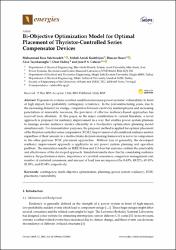Bi-Objective Optimization Model for Optimal Placement of Thyristor-Controlled Series Compensator Devices

View/
Date
2019Author
Salehizadeh, Mohammad RezaKoohbijari, Mahdi Amidi
Nouri, Hassan
Tasçıkaraoğlu, Akın
Erdinç, Ozan
Catalao, Joao P. S.
Metadata
Show full item recordAbstract
Exposure to extreme weather conditions increases power systems' vulnerability in front of high impact, low probability contingency occurrence. In the post-restructuring years, due to the increasing demand for energy, competition between electricity market players and increasing penetration of renewable resources, the provision of effective resiliency-based approaches has received more attention. In this paper, as the major contribution to current literature, a novel approach is proposed for resiliency improvement in a way that enables power system planners to manage several resilience metrics efficiently in a bi-objective optimization planning model simultaneously. For demonstration purposes, the proposed method is applied for optimal placement of the thyristor controlled series compensator (TCSC). Improvement of all considered resilience metrics regardless of their amount in a multi-criteria decision-making framework is novel in comparison to the other previous TCSC placement approaches. Without loss of generality, the developed resiliency improvement approach is applicable in any power system planning and operation problem. The simulation results on IEEE 30-bus and 118-bus test systems confirm the practicality and effectiveness of the developed approach. Simulation results show that by considering resilience metrics, the performance index, importance of curtailed consumers, congestion management cost, number of curtailed consumers, and amount of load loss are improved by 0.63%, 43.52%, 65.19%, 85.93%, and 85.94%, respectively.

















